RMIT Business College: Comparison with Private Colleges in Singapore
VerifiedAdded on 2023/04/21
|21
|4818
|108
Report
AI Summary
This report provides a comprehensive analysis of RMIT Business College in Singapore, comparing it to private colleges. The introduction outlines the scope, followed by an external environment analysis using PESTLE, identifying political, economic, sociological, technological, and environmental factors. An industry analysis employs Porter's Five Forces to assess competitive rivalry, supplier power, buyer power, and the threat of new entrants. The internal environment is examined through strategic capabilities, the VRIO framework, and value chain analysis. A SWOT analysis summarizes strengths, weaknesses, opportunities, and threats. The report concludes with insights into RMIT's competitive position and strategic recommendations for addressing challenges and improving its market position within the Singapore higher education landscape. The report covers topics like VUCA, strategic leadership, and the competitive dynamics within the education sector.
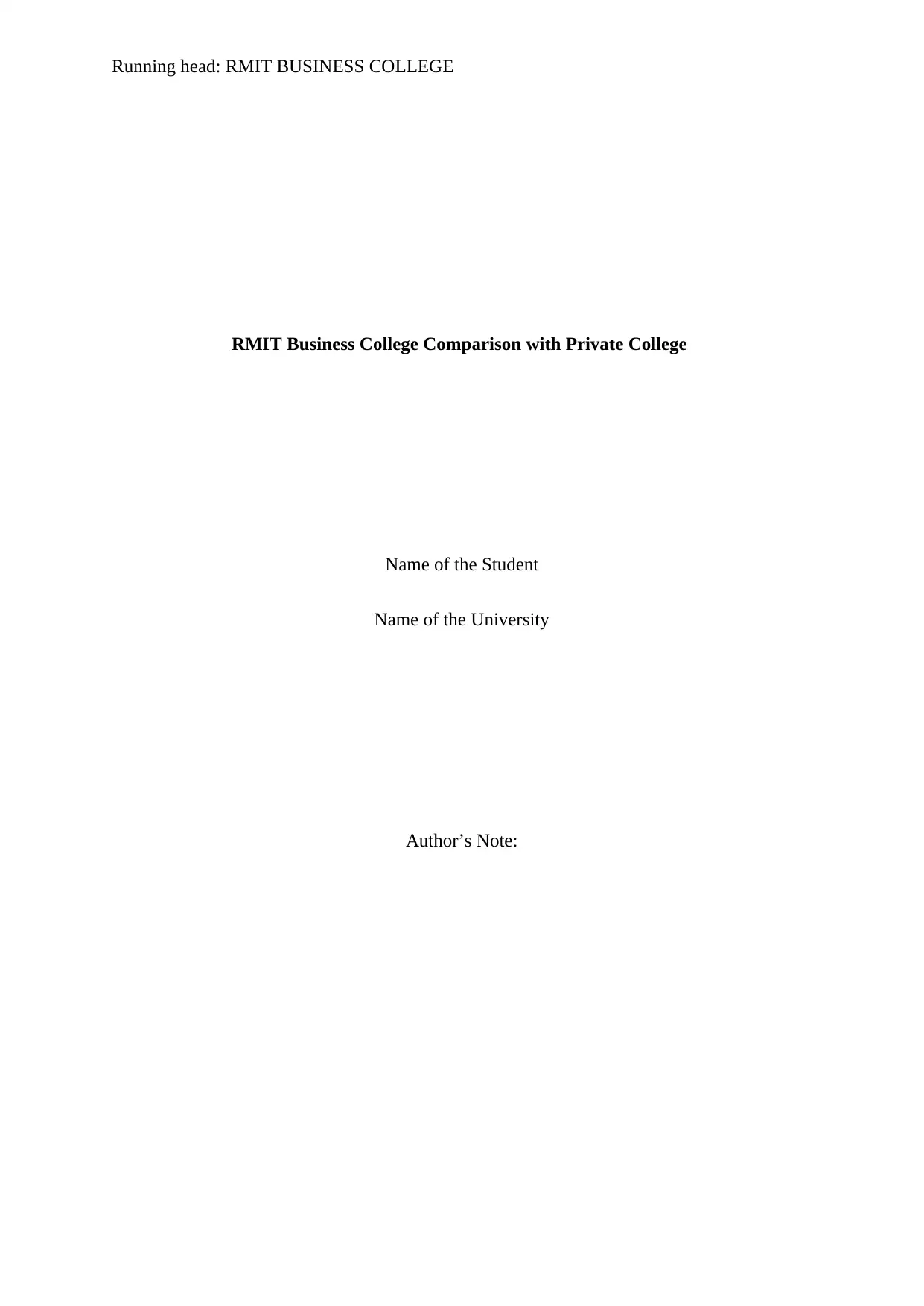
Running head: RMIT BUSINESS COLLEGE
RMIT Business College Comparison with Private College
Name of the Student
Name of the University
Author’s Note:
RMIT Business College Comparison with Private College
Name of the Student
Name of the University
Author’s Note:
Paraphrase This Document
Need a fresh take? Get an instant paraphrase of this document with our AI Paraphraser
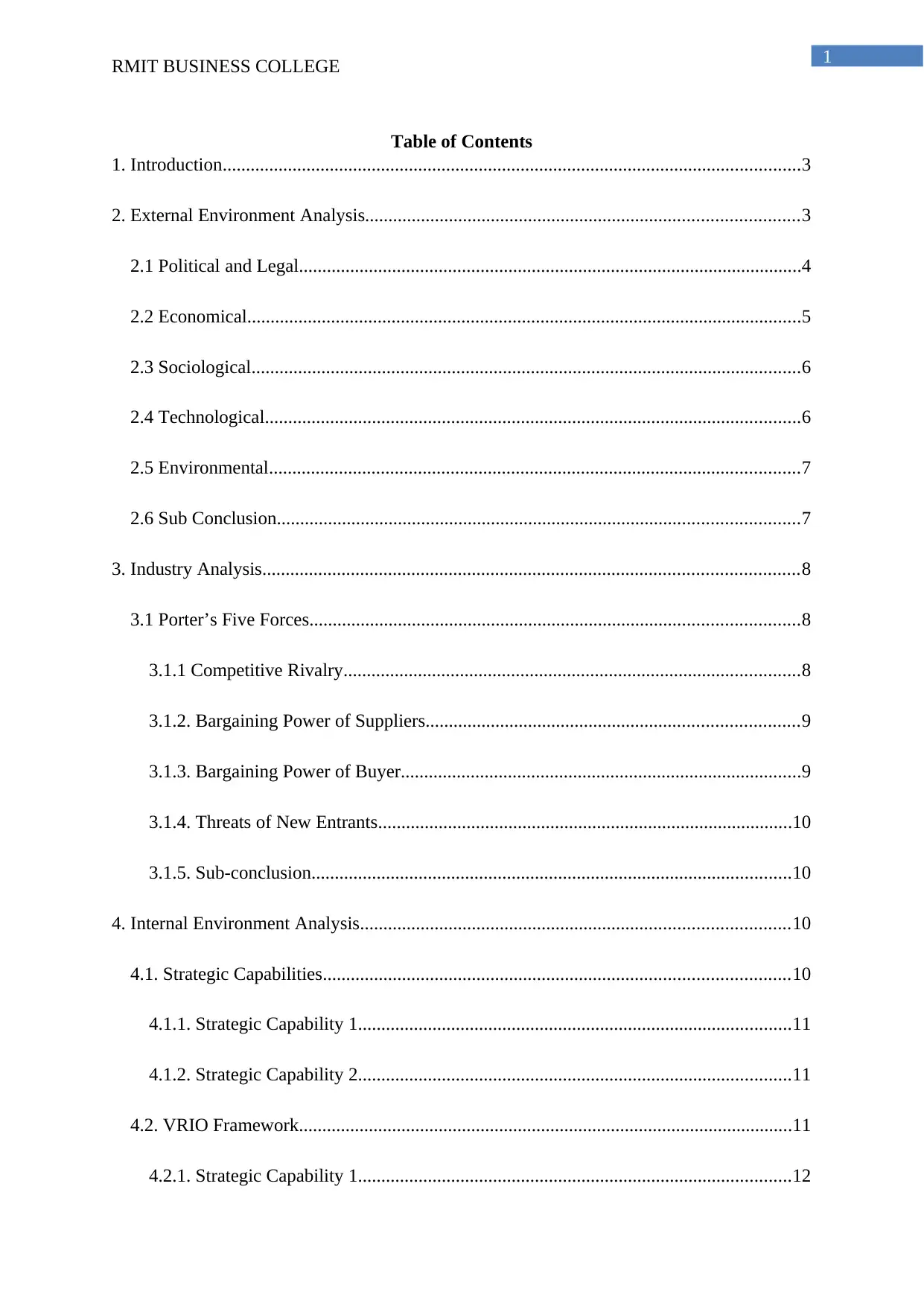
1
RMIT BUSINESS COLLEGE
Table of Contents
1. Introduction............................................................................................................................3
2. External Environment Analysis.............................................................................................3
2.1 Political and Legal............................................................................................................4
2.2 Economical.......................................................................................................................5
2.3 Sociological......................................................................................................................6
2.4 Technological...................................................................................................................6
2.5 Environmental..................................................................................................................7
2.6 Sub Conclusion................................................................................................................7
3. Industry Analysis...................................................................................................................8
3.1 Porter’s Five Forces.........................................................................................................8
3.1.1 Competitive Rivalry..................................................................................................8
3.1.2. Bargaining Power of Suppliers................................................................................9
3.1.3. Bargaining Power of Buyer......................................................................................9
3.1.4. Threats of New Entrants.........................................................................................10
3.1.5. Sub-conclusion.......................................................................................................10
4. Internal Environment Analysis............................................................................................10
4.1. Strategic Capabilities....................................................................................................10
4.1.1. Strategic Capability 1.............................................................................................11
4.1.2. Strategic Capability 2.............................................................................................11
4.2. VRIO Framework..........................................................................................................11
4.2.1. Strategic Capability 1.............................................................................................12
RMIT BUSINESS COLLEGE
Table of Contents
1. Introduction............................................................................................................................3
2. External Environment Analysis.............................................................................................3
2.1 Political and Legal............................................................................................................4
2.2 Economical.......................................................................................................................5
2.3 Sociological......................................................................................................................6
2.4 Technological...................................................................................................................6
2.5 Environmental..................................................................................................................7
2.6 Sub Conclusion................................................................................................................7
3. Industry Analysis...................................................................................................................8
3.1 Porter’s Five Forces.........................................................................................................8
3.1.1 Competitive Rivalry..................................................................................................8
3.1.2. Bargaining Power of Suppliers................................................................................9
3.1.3. Bargaining Power of Buyer......................................................................................9
3.1.4. Threats of New Entrants.........................................................................................10
3.1.5. Sub-conclusion.......................................................................................................10
4. Internal Environment Analysis............................................................................................10
4.1. Strategic Capabilities....................................................................................................10
4.1.1. Strategic Capability 1.............................................................................................11
4.1.2. Strategic Capability 2.............................................................................................11
4.2. VRIO Framework..........................................................................................................11
4.2.1. Strategic Capability 1.............................................................................................12
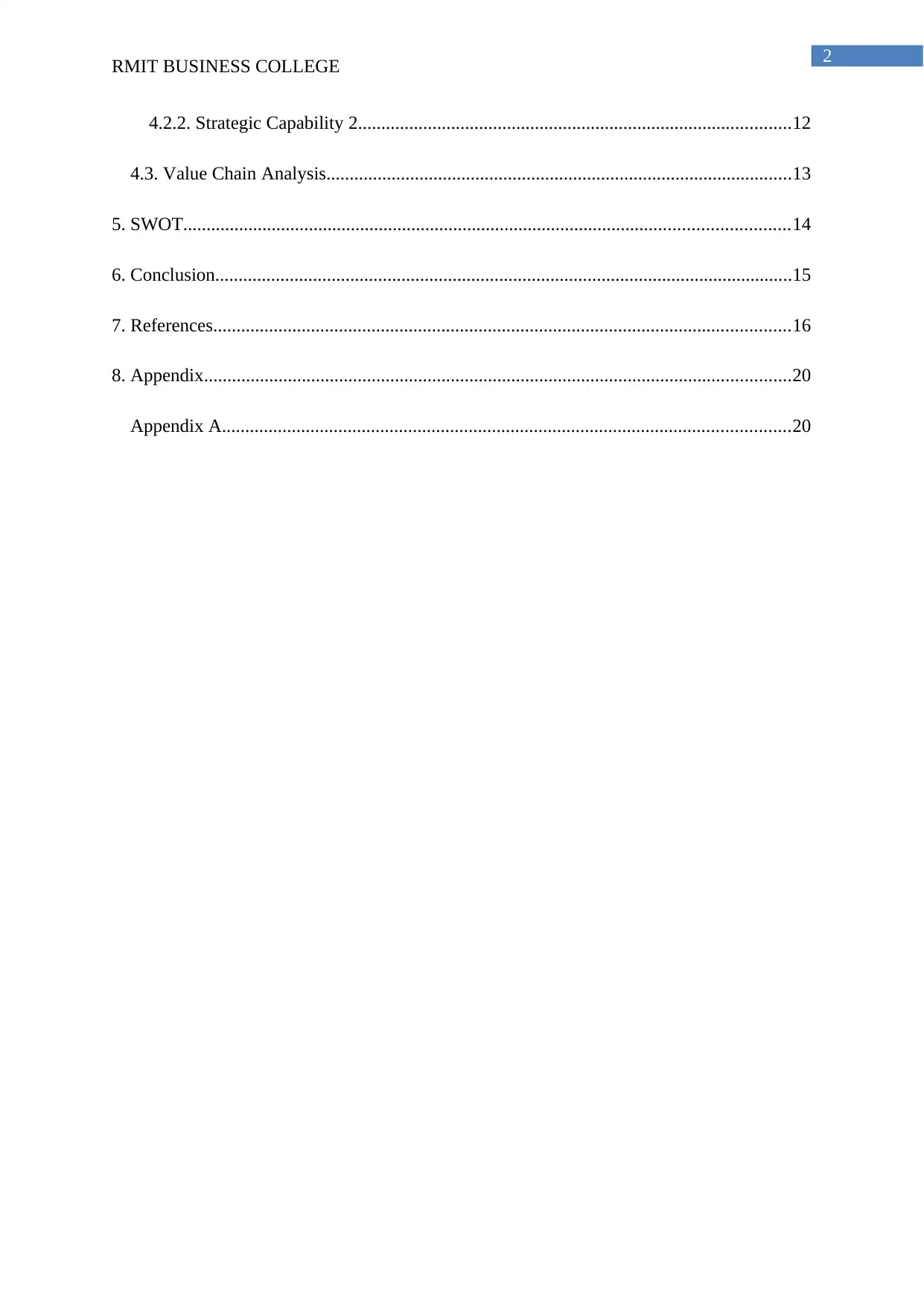
2
RMIT BUSINESS COLLEGE
4.2.2. Strategic Capability 2.............................................................................................12
4.3. Value Chain Analysis....................................................................................................13
5. SWOT..................................................................................................................................14
6. Conclusion............................................................................................................................15
7. References............................................................................................................................16
8. Appendix..............................................................................................................................20
Appendix A..........................................................................................................................20
RMIT BUSINESS COLLEGE
4.2.2. Strategic Capability 2.............................................................................................12
4.3. Value Chain Analysis....................................................................................................13
5. SWOT..................................................................................................................................14
6. Conclusion............................................................................................................................15
7. References............................................................................................................................16
8. Appendix..............................................................................................................................20
Appendix A..........................................................................................................................20
⊘ This is a preview!⊘
Do you want full access?
Subscribe today to unlock all pages.

Trusted by 1+ million students worldwide
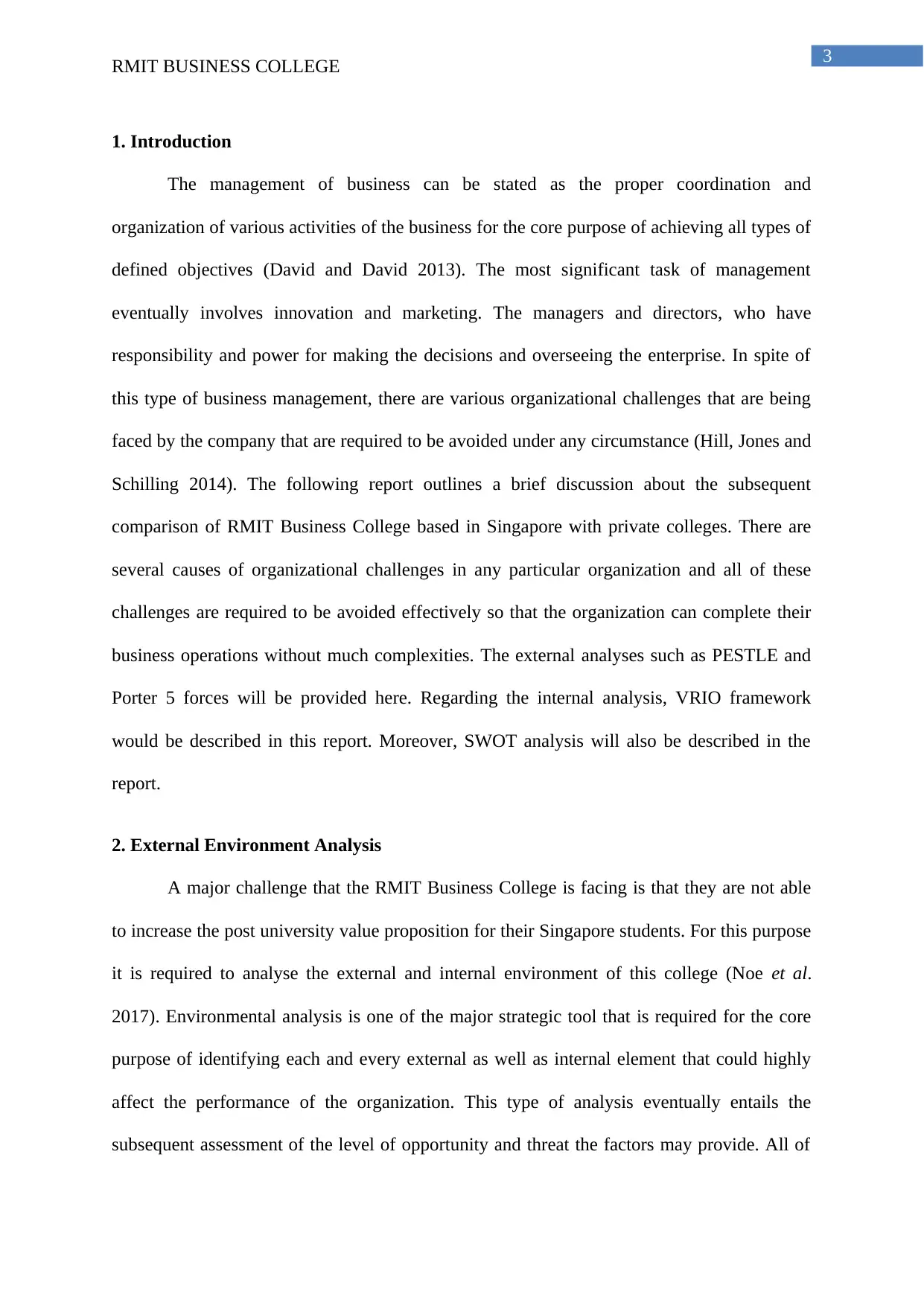
3
RMIT BUSINESS COLLEGE
1. Introduction
The management of business can be stated as the proper coordination and
organization of various activities of the business for the core purpose of achieving all types of
defined objectives (David and David 2013). The most significant task of management
eventually involves innovation and marketing. The managers and directors, who have
responsibility and power for making the decisions and overseeing the enterprise. In spite of
this type of business management, there are various organizational challenges that are being
faced by the company that are required to be avoided under any circumstance (Hill, Jones and
Schilling 2014). The following report outlines a brief discussion about the subsequent
comparison of RMIT Business College based in Singapore with private colleges. There are
several causes of organizational challenges in any particular organization and all of these
challenges are required to be avoided effectively so that the organization can complete their
business operations without much complexities. The external analyses such as PESTLE and
Porter 5 forces will be provided here. Regarding the internal analysis, VRIO framework
would be described in this report. Moreover, SWOT analysis will also be described in the
report.
2. External Environment Analysis
A major challenge that the RMIT Business College is facing is that they are not able
to increase the post university value proposition for their Singapore students. For this purpose
it is required to analyse the external and internal environment of this college (Noe et al.
2017). Environmental analysis is one of the major strategic tool that is required for the core
purpose of identifying each and every external as well as internal element that could highly
affect the performance of the organization. This type of analysis eventually entails the
subsequent assessment of the level of opportunity and threat the factors may provide. All of
RMIT BUSINESS COLLEGE
1. Introduction
The management of business can be stated as the proper coordination and
organization of various activities of the business for the core purpose of achieving all types of
defined objectives (David and David 2013). The most significant task of management
eventually involves innovation and marketing. The managers and directors, who have
responsibility and power for making the decisions and overseeing the enterprise. In spite of
this type of business management, there are various organizational challenges that are being
faced by the company that are required to be avoided under any circumstance (Hill, Jones and
Schilling 2014). The following report outlines a brief discussion about the subsequent
comparison of RMIT Business College based in Singapore with private colleges. There are
several causes of organizational challenges in any particular organization and all of these
challenges are required to be avoided effectively so that the organization can complete their
business operations without much complexities. The external analyses such as PESTLE and
Porter 5 forces will be provided here. Regarding the internal analysis, VRIO framework
would be described in this report. Moreover, SWOT analysis will also be described in the
report.
2. External Environment Analysis
A major challenge that the RMIT Business College is facing is that they are not able
to increase the post university value proposition for their Singapore students. For this purpose
it is required to analyse the external and internal environment of this college (Noe et al.
2017). Environmental analysis is one of the major strategic tool that is required for the core
purpose of identifying each and every external as well as internal element that could highly
affect the performance of the organization. This type of analysis eventually entails the
subsequent assessment of the level of opportunity and threat the factors may provide. All of
Paraphrase This Document
Need a fresh take? Get an instant paraphrase of this document with our AI Paraphraser
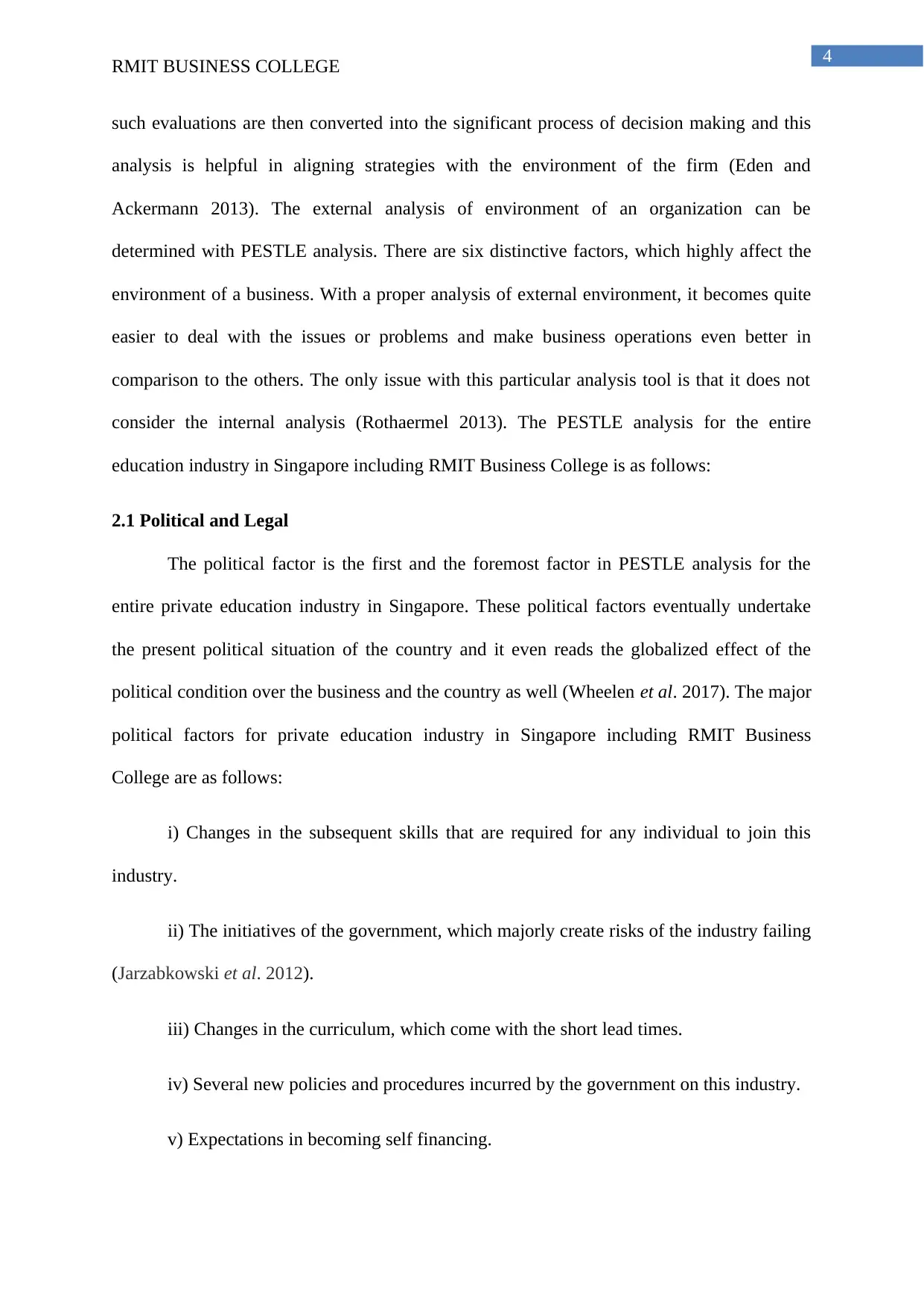
4
RMIT BUSINESS COLLEGE
such evaluations are then converted into the significant process of decision making and this
analysis is helpful in aligning strategies with the environment of the firm (Eden and
Ackermann 2013). The external analysis of environment of an organization can be
determined with PESTLE analysis. There are six distinctive factors, which highly affect the
environment of a business. With a proper analysis of external environment, it becomes quite
easier to deal with the issues or problems and make business operations even better in
comparison to the others. The only issue with this particular analysis tool is that it does not
consider the internal analysis (Rothaermel 2013). The PESTLE analysis for the entire
education industry in Singapore including RMIT Business College is as follows:
2.1 Political and Legal
The political factor is the first and the foremost factor in PESTLE analysis for the
entire private education industry in Singapore. These political factors eventually undertake
the present political situation of the country and it even reads the globalized effect of the
political condition over the business and the country as well (Wheelen et al. 2017). The major
political factors for private education industry in Singapore including RMIT Business
College are as follows:
i) Changes in the subsequent skills that are required for any individual to join this
industry.
ii) The initiatives of the government, which majorly create risks of the industry failing
(Jarzabkowski et al. 2012).
iii) Changes in the curriculum, which come with the short lead times.
iv) Several new policies and procedures incurred by the government on this industry.
v) Expectations in becoming self financing.
RMIT BUSINESS COLLEGE
such evaluations are then converted into the significant process of decision making and this
analysis is helpful in aligning strategies with the environment of the firm (Eden and
Ackermann 2013). The external analysis of environment of an organization can be
determined with PESTLE analysis. There are six distinctive factors, which highly affect the
environment of a business. With a proper analysis of external environment, it becomes quite
easier to deal with the issues or problems and make business operations even better in
comparison to the others. The only issue with this particular analysis tool is that it does not
consider the internal analysis (Rothaermel 2013). The PESTLE analysis for the entire
education industry in Singapore including RMIT Business College is as follows:
2.1 Political and Legal
The political factor is the first and the foremost factor in PESTLE analysis for the
entire private education industry in Singapore. These political factors eventually undertake
the present political situation of the country and it even reads the globalized effect of the
political condition over the business and the country as well (Wheelen et al. 2017). The major
political factors for private education industry in Singapore including RMIT Business
College are as follows:
i) Changes in the subsequent skills that are required for any individual to join this
industry.
ii) The initiatives of the government, which majorly create risks of the industry failing
(Jarzabkowski et al. 2012).
iii) Changes in the curriculum, which come with the short lead times.
iv) Several new policies and procedures incurred by the government on this industry.
v) Expectations in becoming self financing.
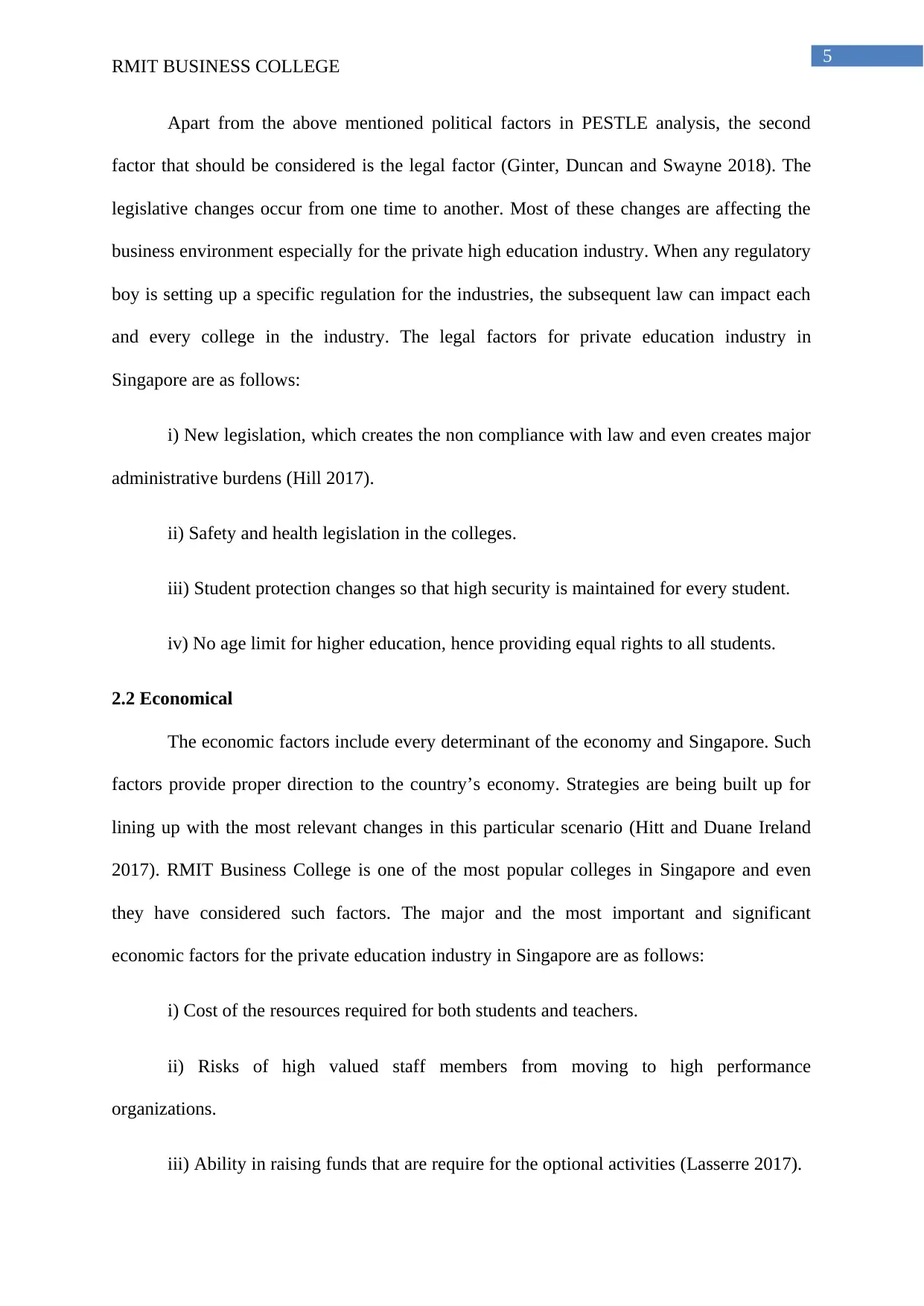
5
RMIT BUSINESS COLLEGE
Apart from the above mentioned political factors in PESTLE analysis, the second
factor that should be considered is the legal factor (Ginter, Duncan and Swayne 2018). The
legislative changes occur from one time to another. Most of these changes are affecting the
business environment especially for the private high education industry. When any regulatory
boy is setting up a specific regulation for the industries, the subsequent law can impact each
and every college in the industry. The legal factors for private education industry in
Singapore are as follows:
i) New legislation, which creates the non compliance with law and even creates major
administrative burdens (Hill 2017).
ii) Safety and health legislation in the colleges.
iii) Student protection changes so that high security is maintained for every student.
iv) No age limit for higher education, hence providing equal rights to all students.
2.2 Economical
The economic factors include every determinant of the economy and Singapore. Such
factors provide proper direction to the country’s economy. Strategies are being built up for
lining up with the most relevant changes in this particular scenario (Hitt and Duane Ireland
2017). RMIT Business College is one of the most popular colleges in Singapore and even
they have considered such factors. The major and the most important and significant
economic factors for the private education industry in Singapore are as follows:
i) Cost of the resources required for both students and teachers.
ii) Risks of high valued staff members from moving to high performance
organizations.
iii) Ability in raising funds that are require for the optional activities (Lasserre 2017).
RMIT BUSINESS COLLEGE
Apart from the above mentioned political factors in PESTLE analysis, the second
factor that should be considered is the legal factor (Ginter, Duncan and Swayne 2018). The
legislative changes occur from one time to another. Most of these changes are affecting the
business environment especially for the private high education industry. When any regulatory
boy is setting up a specific regulation for the industries, the subsequent law can impact each
and every college in the industry. The legal factors for private education industry in
Singapore are as follows:
i) New legislation, which creates the non compliance with law and even creates major
administrative burdens (Hill 2017).
ii) Safety and health legislation in the colleges.
iii) Student protection changes so that high security is maintained for every student.
iv) No age limit for higher education, hence providing equal rights to all students.
2.2 Economical
The economic factors include every determinant of the economy and Singapore. Such
factors provide proper direction to the country’s economy. Strategies are being built up for
lining up with the most relevant changes in this particular scenario (Hitt and Duane Ireland
2017). RMIT Business College is one of the most popular colleges in Singapore and even
they have considered such factors. The major and the most important and significant
economic factors for the private education industry in Singapore are as follows:
i) Cost of the resources required for both students and teachers.
ii) Risks of high valued staff members from moving to high performance
organizations.
iii) Ability in raising funds that are require for the optional activities (Lasserre 2017).
⊘ This is a preview!⊘
Do you want full access?
Subscribe today to unlock all pages.

Trusted by 1+ million students worldwide
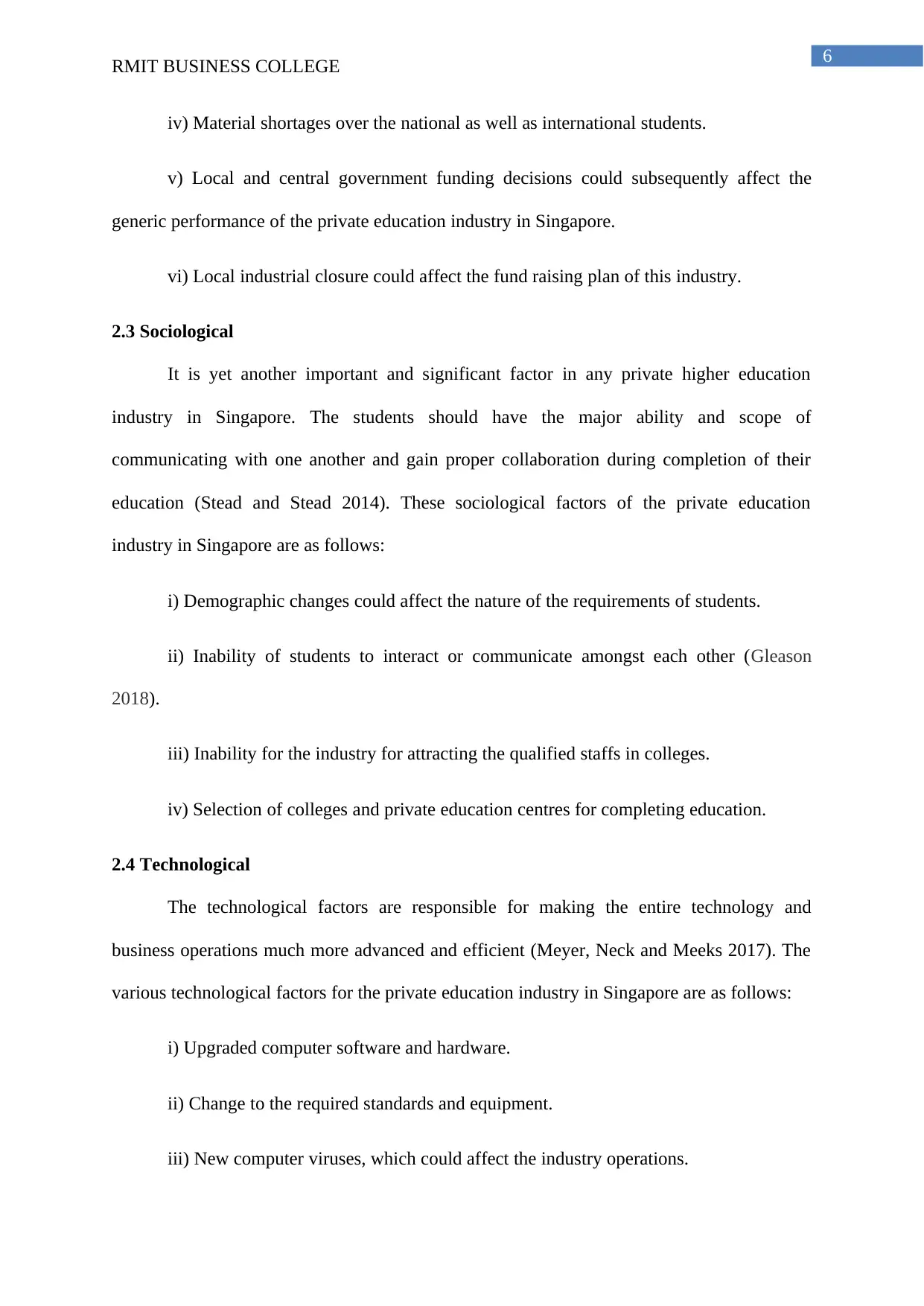
6
RMIT BUSINESS COLLEGE
iv) Material shortages over the national as well as international students.
v) Local and central government funding decisions could subsequently affect the
generic performance of the private education industry in Singapore.
vi) Local industrial closure could affect the fund raising plan of this industry.
2.3 Sociological
It is yet another important and significant factor in any private higher education
industry in Singapore. The students should have the major ability and scope of
communicating with one another and gain proper collaboration during completion of their
education (Stead and Stead 2014). These sociological factors of the private education
industry in Singapore are as follows:
i) Demographic changes could affect the nature of the requirements of students.
ii) Inability of students to interact or communicate amongst each other (Gleason
2018).
iii) Inability for the industry for attracting the qualified staffs in colleges.
iv) Selection of colleges and private education centres for completing education.
2.4 Technological
The technological factors are responsible for making the entire technology and
business operations much more advanced and efficient (Meyer, Neck and Meeks 2017). The
various technological factors for the private education industry in Singapore are as follows:
i) Upgraded computer software and hardware.
ii) Change to the required standards and equipment.
iii) New computer viruses, which could affect the industry operations.
RMIT BUSINESS COLLEGE
iv) Material shortages over the national as well as international students.
v) Local and central government funding decisions could subsequently affect the
generic performance of the private education industry in Singapore.
vi) Local industrial closure could affect the fund raising plan of this industry.
2.3 Sociological
It is yet another important and significant factor in any private higher education
industry in Singapore. The students should have the major ability and scope of
communicating with one another and gain proper collaboration during completion of their
education (Stead and Stead 2014). These sociological factors of the private education
industry in Singapore are as follows:
i) Demographic changes could affect the nature of the requirements of students.
ii) Inability of students to interact or communicate amongst each other (Gleason
2018).
iii) Inability for the industry for attracting the qualified staffs in colleges.
iv) Selection of colleges and private education centres for completing education.
2.4 Technological
The technological factors are responsible for making the entire technology and
business operations much more advanced and efficient (Meyer, Neck and Meeks 2017). The
various technological factors for the private education industry in Singapore are as follows:
i) Upgraded computer software and hardware.
ii) Change to the required standards and equipment.
iii) New computer viruses, which could affect the industry operations.
Paraphrase This Document
Need a fresh take? Get an instant paraphrase of this document with our AI Paraphraser
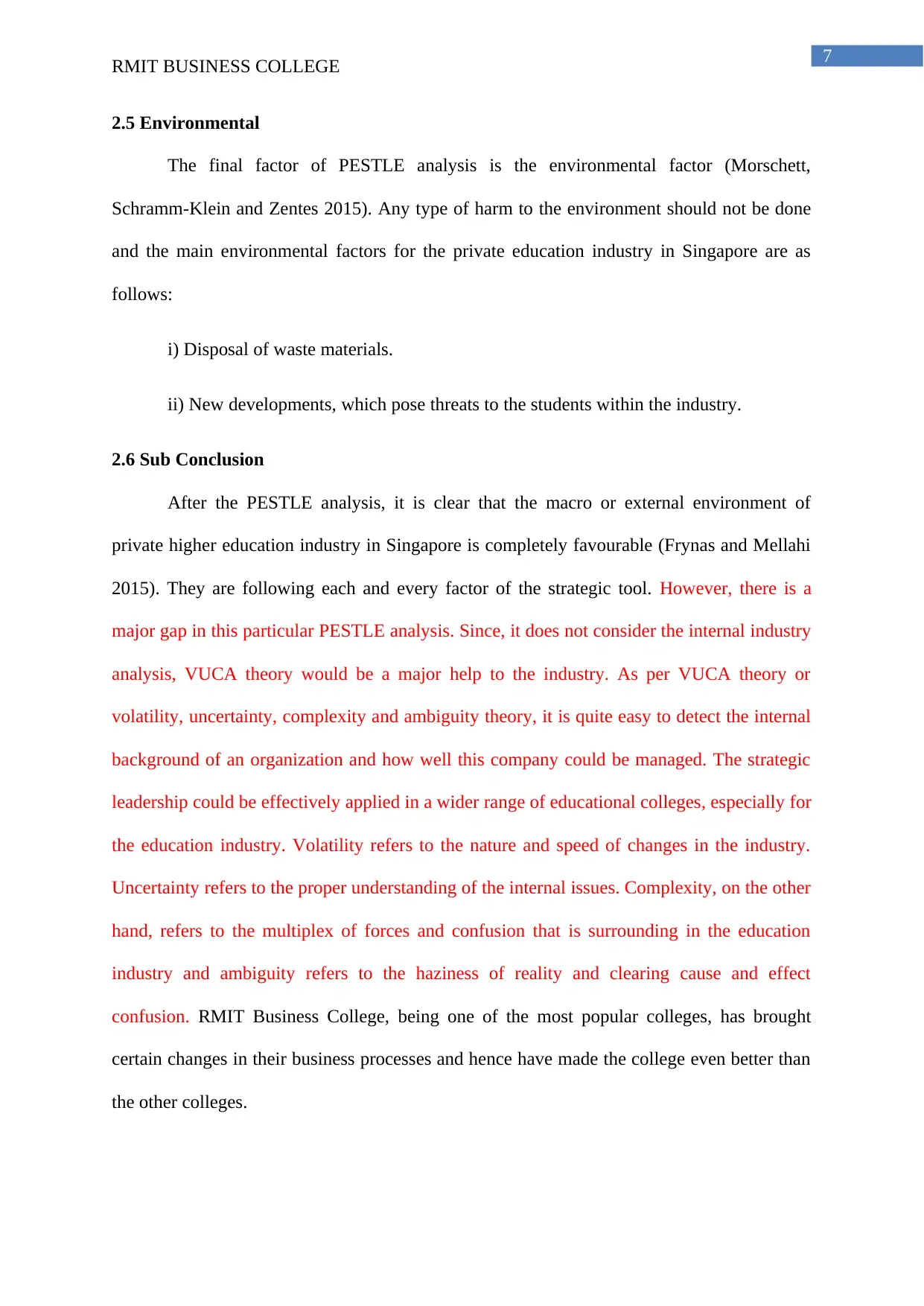
7
RMIT BUSINESS COLLEGE
2.5 Environmental
The final factor of PESTLE analysis is the environmental factor (Morschett,
Schramm-Klein and Zentes 2015). Any type of harm to the environment should not be done
and the main environmental factors for the private education industry in Singapore are as
follows:
i) Disposal of waste materials.
ii) New developments, which pose threats to the students within the industry.
2.6 Sub Conclusion
After the PESTLE analysis, it is clear that the macro or external environment of
private higher education industry in Singapore is completely favourable (Frynas and Mellahi
2015). They are following each and every factor of the strategic tool. However, there is a
major gap in this particular PESTLE analysis. Since, it does not consider the internal industry
analysis, VUCA theory would be a major help to the industry. As per VUCA theory or
volatility, uncertainty, complexity and ambiguity theory, it is quite easy to detect the internal
background of an organization and how well this company could be managed. The strategic
leadership could be effectively applied in a wider range of educational colleges, especially for
the education industry. Volatility refers to the nature and speed of changes in the industry.
Uncertainty refers to the proper understanding of the internal issues. Complexity, on the other
hand, refers to the multiplex of forces and confusion that is surrounding in the education
industry and ambiguity refers to the haziness of reality and clearing cause and effect
confusion. RMIT Business College, being one of the most popular colleges, has brought
certain changes in their business processes and hence have made the college even better than
the other colleges.
RMIT BUSINESS COLLEGE
2.5 Environmental
The final factor of PESTLE analysis is the environmental factor (Morschett,
Schramm-Klein and Zentes 2015). Any type of harm to the environment should not be done
and the main environmental factors for the private education industry in Singapore are as
follows:
i) Disposal of waste materials.
ii) New developments, which pose threats to the students within the industry.
2.6 Sub Conclusion
After the PESTLE analysis, it is clear that the macro or external environment of
private higher education industry in Singapore is completely favourable (Frynas and Mellahi
2015). They are following each and every factor of the strategic tool. However, there is a
major gap in this particular PESTLE analysis. Since, it does not consider the internal industry
analysis, VUCA theory would be a major help to the industry. As per VUCA theory or
volatility, uncertainty, complexity and ambiguity theory, it is quite easy to detect the internal
background of an organization and how well this company could be managed. The strategic
leadership could be effectively applied in a wider range of educational colleges, especially for
the education industry. Volatility refers to the nature and speed of changes in the industry.
Uncertainty refers to the proper understanding of the internal issues. Complexity, on the other
hand, refers to the multiplex of forces and confusion that is surrounding in the education
industry and ambiguity refers to the haziness of reality and clearing cause and effect
confusion. RMIT Business College, being one of the most popular colleges, has brought
certain changes in their business processes and hence have made the college even better than
the other colleges.
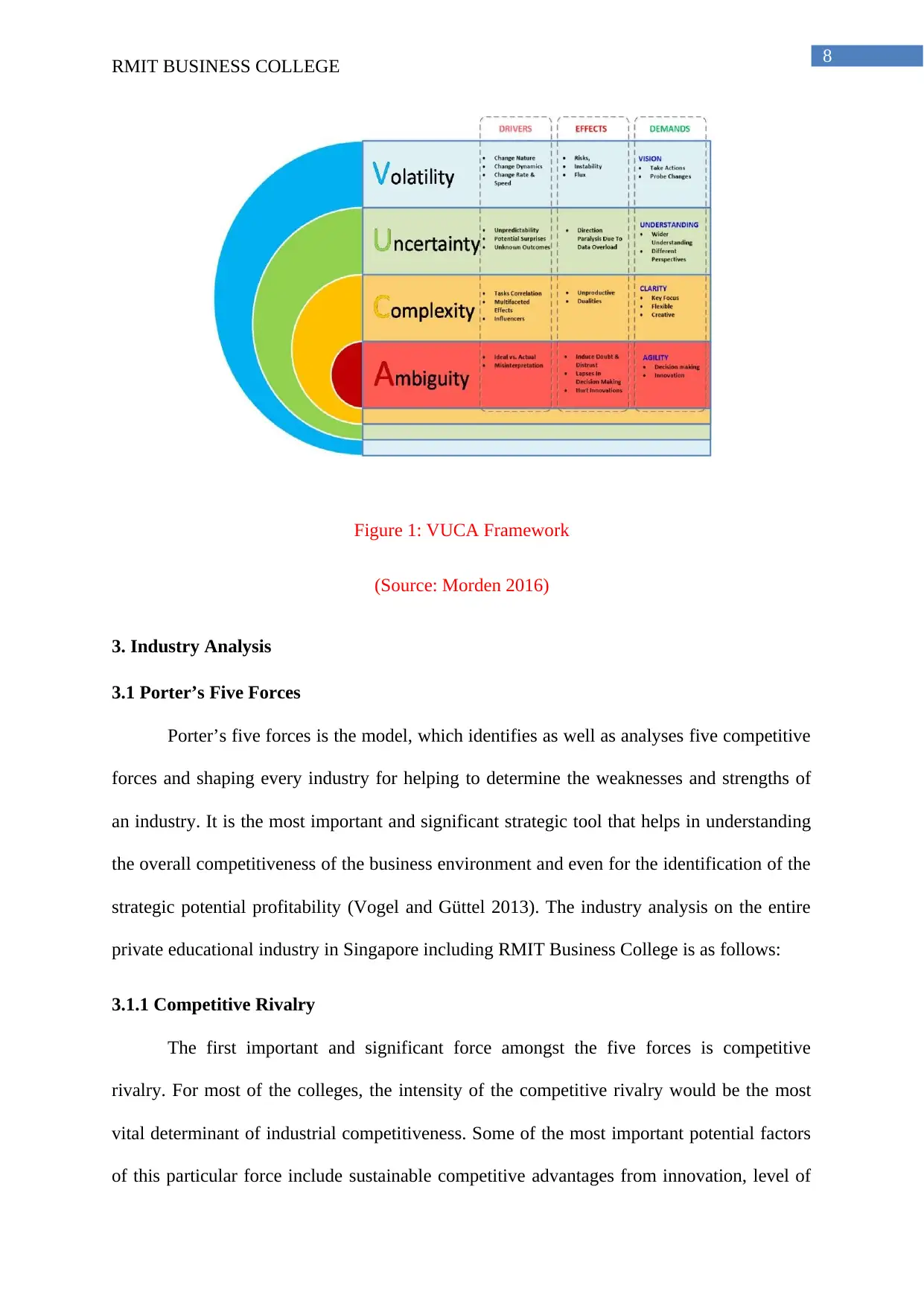
8
RMIT BUSINESS COLLEGE
Figure 1: VUCA Framework
(Source: Morden 2016)
3. Industry Analysis
3.1 Porter’s Five Forces
Porter’s five forces is the model, which identifies as well as analyses five competitive
forces and shaping every industry for helping to determine the weaknesses and strengths of
an industry. It is the most important and significant strategic tool that helps in understanding
the overall competitiveness of the business environment and even for the identification of the
strategic potential profitability (Vogel and Güttel 2013). The industry analysis on the entire
private educational industry in Singapore including RMIT Business College is as follows:
3.1.1 Competitive Rivalry
The first important and significant force amongst the five forces is competitive
rivalry. For most of the colleges, the intensity of the competitive rivalry would be the most
vital determinant of industrial competitiveness. Some of the most important potential factors
of this particular force include sustainable competitive advantages from innovation, level of
RMIT BUSINESS COLLEGE
Figure 1: VUCA Framework
(Source: Morden 2016)
3. Industry Analysis
3.1 Porter’s Five Forces
Porter’s five forces is the model, which identifies as well as analyses five competitive
forces and shaping every industry for helping to determine the weaknesses and strengths of
an industry. It is the most important and significant strategic tool that helps in understanding
the overall competitiveness of the business environment and even for the identification of the
strategic potential profitability (Vogel and Güttel 2013). The industry analysis on the entire
private educational industry in Singapore including RMIT Business College is as follows:
3.1.1 Competitive Rivalry
The first important and significant force amongst the five forces is competitive
rivalry. For most of the colleges, the intensity of the competitive rivalry would be the most
vital determinant of industrial competitiveness. Some of the most important potential factors
of this particular force include sustainable competitive advantages from innovation, level of
⊘ This is a preview!⊘
Do you want full access?
Subscribe today to unlock all pages.

Trusted by 1+ million students worldwide
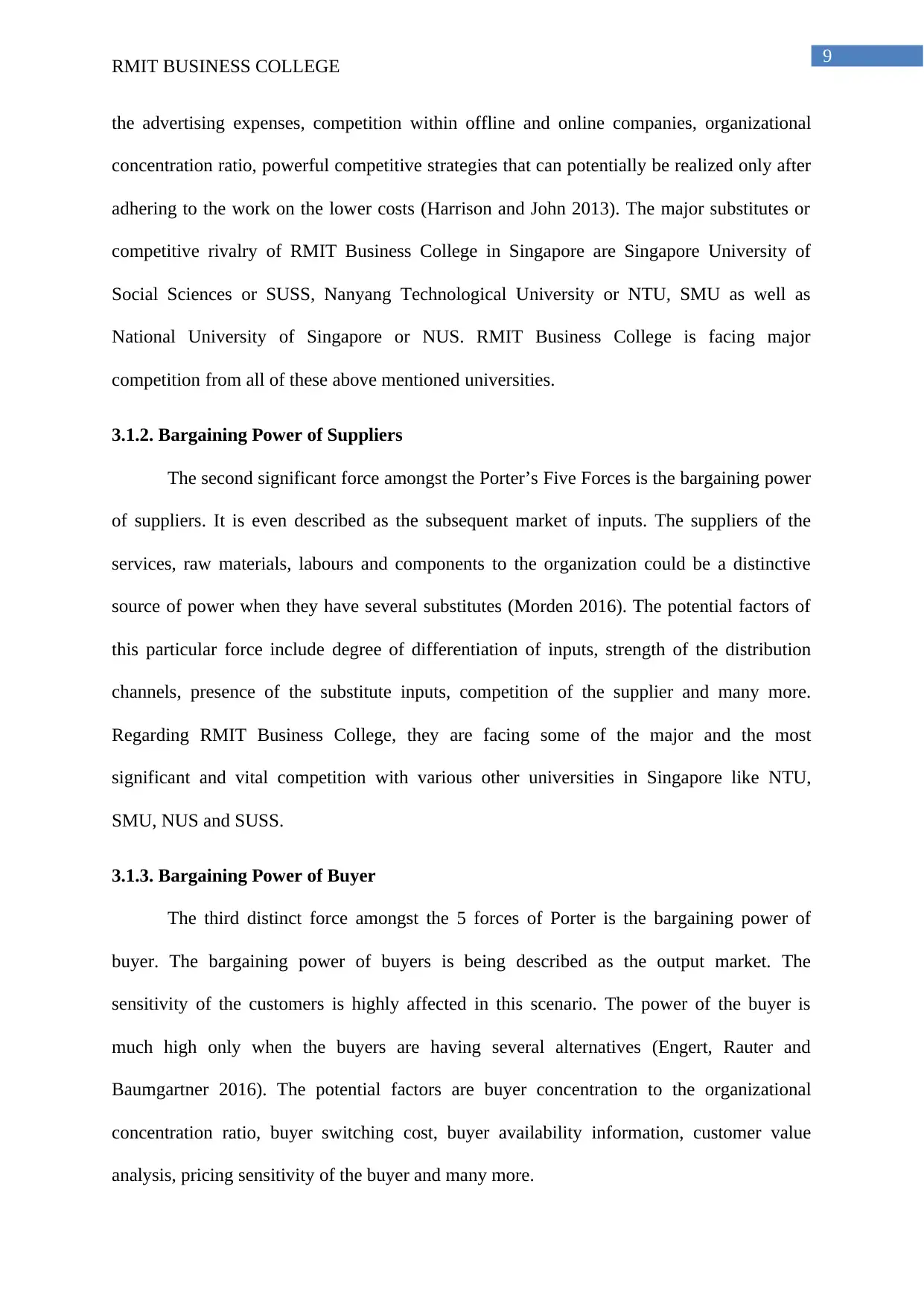
9
RMIT BUSINESS COLLEGE
the advertising expenses, competition within offline and online companies, organizational
concentration ratio, powerful competitive strategies that can potentially be realized only after
adhering to the work on the lower costs (Harrison and John 2013). The major substitutes or
competitive rivalry of RMIT Business College in Singapore are Singapore University of
Social Sciences or SUSS, Nanyang Technological University or NTU, SMU as well as
National University of Singapore or NUS. RMIT Business College is facing major
competition from all of these above mentioned universities.
3.1.2. Bargaining Power of Suppliers
The second significant force amongst the Porter’s Five Forces is the bargaining power
of suppliers. It is even described as the subsequent market of inputs. The suppliers of the
services, raw materials, labours and components to the organization could be a distinctive
source of power when they have several substitutes (Morden 2016). The potential factors of
this particular force include degree of differentiation of inputs, strength of the distribution
channels, presence of the substitute inputs, competition of the supplier and many more.
Regarding RMIT Business College, they are facing some of the major and the most
significant and vital competition with various other universities in Singapore like NTU,
SMU, NUS and SUSS.
3.1.3. Bargaining Power of Buyer
The third distinct force amongst the 5 forces of Porter is the bargaining power of
buyer. The bargaining power of buyers is being described as the output market. The
sensitivity of the customers is highly affected in this scenario. The power of the buyer is
much high only when the buyers are having several alternatives (Engert, Rauter and
Baumgartner 2016). The potential factors are buyer concentration to the organizational
concentration ratio, buyer switching cost, buyer availability information, customer value
analysis, pricing sensitivity of the buyer and many more.
RMIT BUSINESS COLLEGE
the advertising expenses, competition within offline and online companies, organizational
concentration ratio, powerful competitive strategies that can potentially be realized only after
adhering to the work on the lower costs (Harrison and John 2013). The major substitutes or
competitive rivalry of RMIT Business College in Singapore are Singapore University of
Social Sciences or SUSS, Nanyang Technological University or NTU, SMU as well as
National University of Singapore or NUS. RMIT Business College is facing major
competition from all of these above mentioned universities.
3.1.2. Bargaining Power of Suppliers
The second significant force amongst the Porter’s Five Forces is the bargaining power
of suppliers. It is even described as the subsequent market of inputs. The suppliers of the
services, raw materials, labours and components to the organization could be a distinctive
source of power when they have several substitutes (Morden 2016). The potential factors of
this particular force include degree of differentiation of inputs, strength of the distribution
channels, presence of the substitute inputs, competition of the supplier and many more.
Regarding RMIT Business College, they are facing some of the major and the most
significant and vital competition with various other universities in Singapore like NTU,
SMU, NUS and SUSS.
3.1.3. Bargaining Power of Buyer
The third distinct force amongst the 5 forces of Porter is the bargaining power of
buyer. The bargaining power of buyers is being described as the output market. The
sensitivity of the customers is highly affected in this scenario. The power of the buyer is
much high only when the buyers are having several alternatives (Engert, Rauter and
Baumgartner 2016). The potential factors are buyer concentration to the organizational
concentration ratio, buyer switching cost, buyer availability information, customer value
analysis, pricing sensitivity of the buyer and many more.
Paraphrase This Document
Need a fresh take? Get an instant paraphrase of this document with our AI Paraphraser
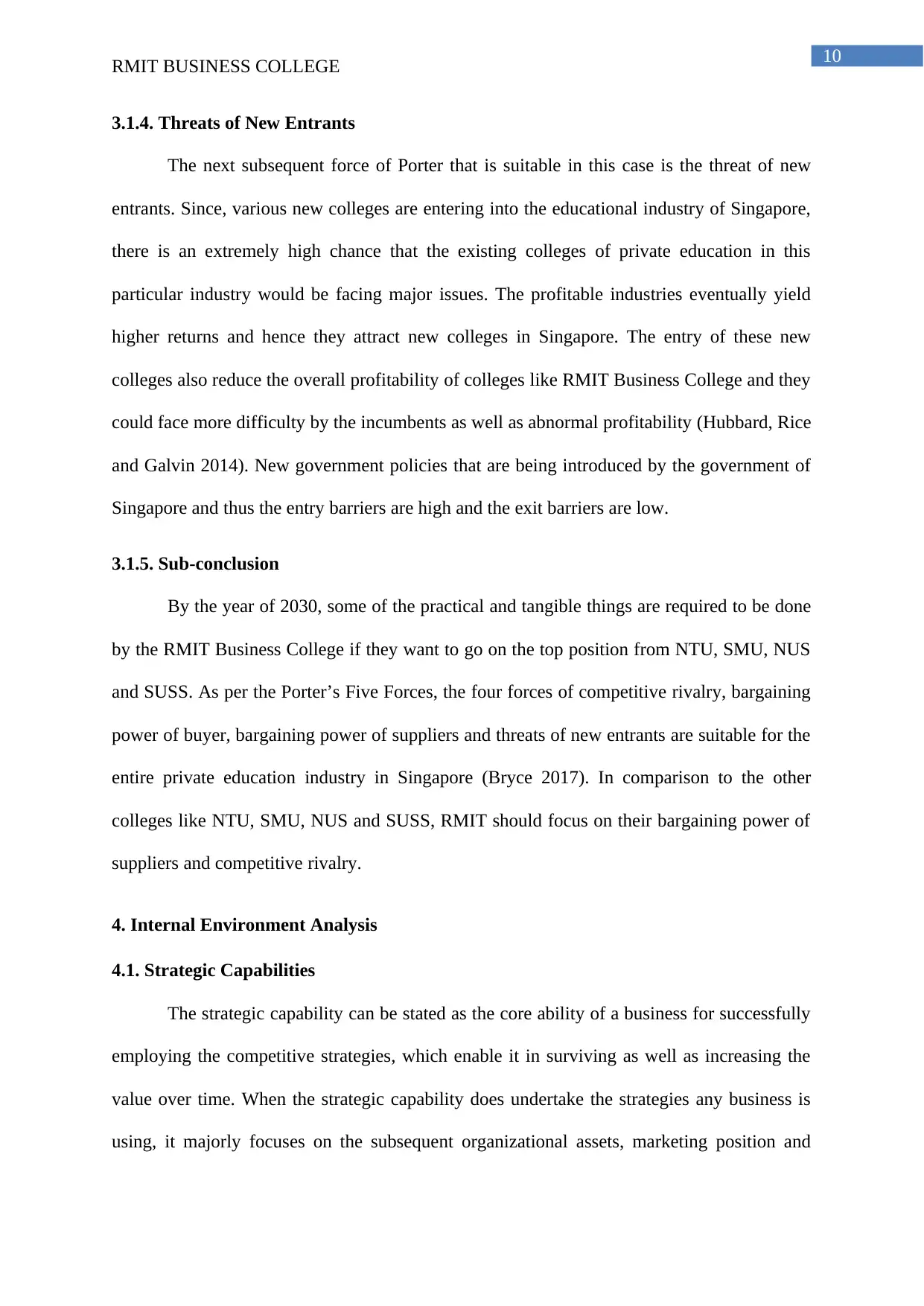
10
RMIT BUSINESS COLLEGE
3.1.4. Threats of New Entrants
The next subsequent force of Porter that is suitable in this case is the threat of new
entrants. Since, various new colleges are entering into the educational industry of Singapore,
there is an extremely high chance that the existing colleges of private education in this
particular industry would be facing major issues. The profitable industries eventually yield
higher returns and hence they attract new colleges in Singapore. The entry of these new
colleges also reduce the overall profitability of colleges like RMIT Business College and they
could face more difficulty by the incumbents as well as abnormal profitability (Hubbard, Rice
and Galvin 2014). New government policies that are being introduced by the government of
Singapore and thus the entry barriers are high and the exit barriers are low.
3.1.5. Sub-conclusion
By the year of 2030, some of the practical and tangible things are required to be done
by the RMIT Business College if they want to go on the top position from NTU, SMU, NUS
and SUSS. As per the Porter’s Five Forces, the four forces of competitive rivalry, bargaining
power of buyer, bargaining power of suppliers and threats of new entrants are suitable for the
entire private education industry in Singapore (Bryce 2017). In comparison to the other
colleges like NTU, SMU, NUS and SUSS, RMIT should focus on their bargaining power of
suppliers and competitive rivalry.
4. Internal Environment Analysis
4.1. Strategic Capabilities
The strategic capability can be stated as the core ability of a business for successfully
employing the competitive strategies, which enable it in surviving as well as increasing the
value over time. When the strategic capability does undertake the strategies any business is
using, it majorly focuses on the subsequent organizational assets, marketing position and
RMIT BUSINESS COLLEGE
3.1.4. Threats of New Entrants
The next subsequent force of Porter that is suitable in this case is the threat of new
entrants. Since, various new colleges are entering into the educational industry of Singapore,
there is an extremely high chance that the existing colleges of private education in this
particular industry would be facing major issues. The profitable industries eventually yield
higher returns and hence they attract new colleges in Singapore. The entry of these new
colleges also reduce the overall profitability of colleges like RMIT Business College and they
could face more difficulty by the incumbents as well as abnormal profitability (Hubbard, Rice
and Galvin 2014). New government policies that are being introduced by the government of
Singapore and thus the entry barriers are high and the exit barriers are low.
3.1.5. Sub-conclusion
By the year of 2030, some of the practical and tangible things are required to be done
by the RMIT Business College if they want to go on the top position from NTU, SMU, NUS
and SUSS. As per the Porter’s Five Forces, the four forces of competitive rivalry, bargaining
power of buyer, bargaining power of suppliers and threats of new entrants are suitable for the
entire private education industry in Singapore (Bryce 2017). In comparison to the other
colleges like NTU, SMU, NUS and SUSS, RMIT should focus on their bargaining power of
suppliers and competitive rivalry.
4. Internal Environment Analysis
4.1. Strategic Capabilities
The strategic capability can be stated as the core ability of a business for successfully
employing the competitive strategies, which enable it in surviving as well as increasing the
value over time. When the strategic capability does undertake the strategies any business is
using, it majorly focuses on the subsequent organizational assets, marketing position and
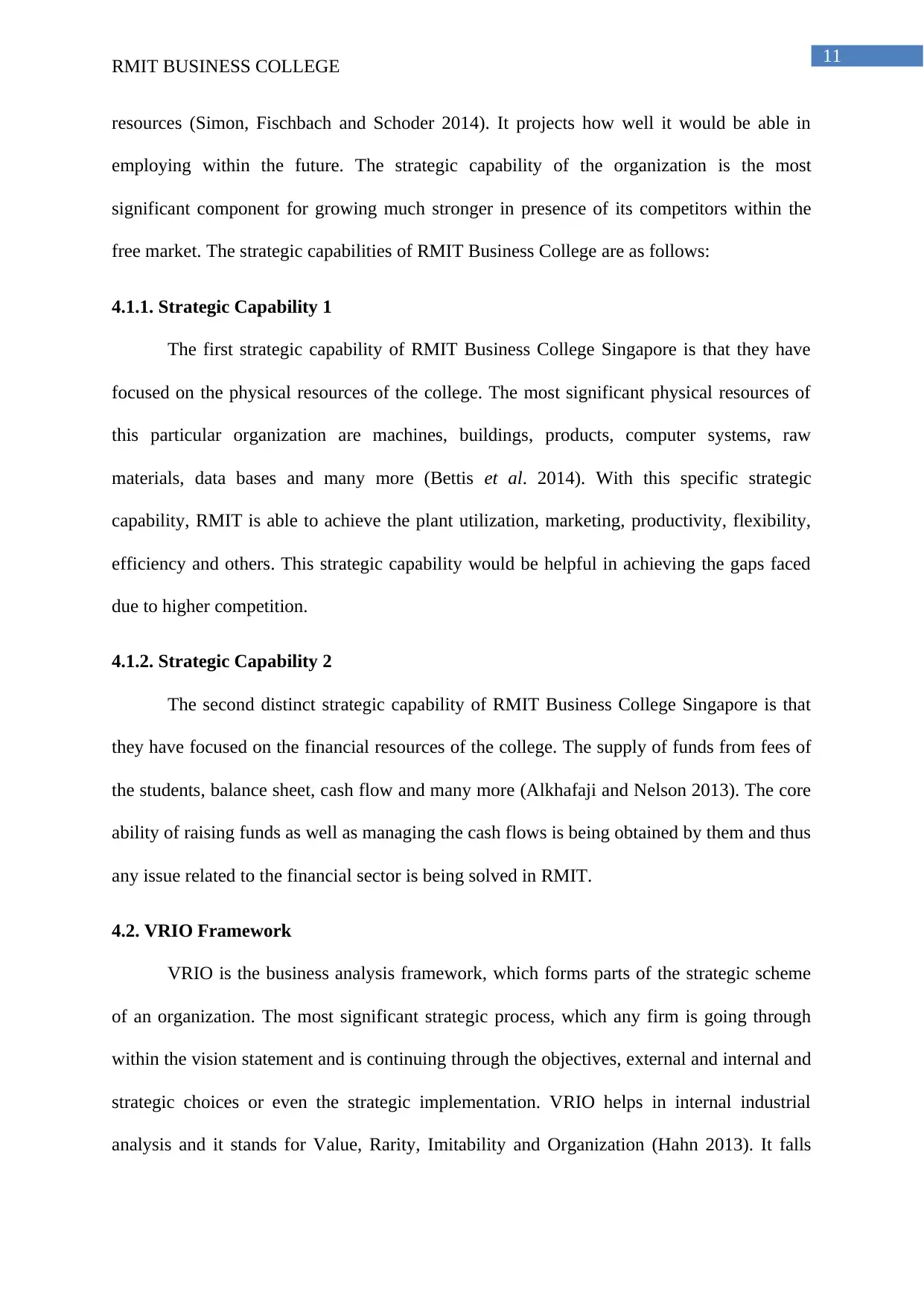
11
RMIT BUSINESS COLLEGE
resources (Simon, Fischbach and Schoder 2014). It projects how well it would be able in
employing within the future. The strategic capability of the organization is the most
significant component for growing much stronger in presence of its competitors within the
free market. The strategic capabilities of RMIT Business College are as follows:
4.1.1. Strategic Capability 1
The first strategic capability of RMIT Business College Singapore is that they have
focused on the physical resources of the college. The most significant physical resources of
this particular organization are machines, buildings, products, computer systems, raw
materials, data bases and many more (Bettis et al. 2014). With this specific strategic
capability, RMIT is able to achieve the plant utilization, marketing, productivity, flexibility,
efficiency and others. This strategic capability would be helpful in achieving the gaps faced
due to higher competition.
4.1.2. Strategic Capability 2
The second distinct strategic capability of RMIT Business College Singapore is that
they have focused on the financial resources of the college. The supply of funds from fees of
the students, balance sheet, cash flow and many more (Alkhafaji and Nelson 2013). The core
ability of raising funds as well as managing the cash flows is being obtained by them and thus
any issue related to the financial sector is being solved in RMIT.
4.2. VRIO Framework
VRIO is the business analysis framework, which forms parts of the strategic scheme
of an organization. The most significant strategic process, which any firm is going through
within the vision statement and is continuing through the objectives, external and internal and
strategic choices or even the strategic implementation. VRIO helps in internal industrial
analysis and it stands for Value, Rarity, Imitability and Organization (Hahn 2013). It falls
RMIT BUSINESS COLLEGE
resources (Simon, Fischbach and Schoder 2014). It projects how well it would be able in
employing within the future. The strategic capability of the organization is the most
significant component for growing much stronger in presence of its competitors within the
free market. The strategic capabilities of RMIT Business College are as follows:
4.1.1. Strategic Capability 1
The first strategic capability of RMIT Business College Singapore is that they have
focused on the physical resources of the college. The most significant physical resources of
this particular organization are machines, buildings, products, computer systems, raw
materials, data bases and many more (Bettis et al. 2014). With this specific strategic
capability, RMIT is able to achieve the plant utilization, marketing, productivity, flexibility,
efficiency and others. This strategic capability would be helpful in achieving the gaps faced
due to higher competition.
4.1.2. Strategic Capability 2
The second distinct strategic capability of RMIT Business College Singapore is that
they have focused on the financial resources of the college. The supply of funds from fees of
the students, balance sheet, cash flow and many more (Alkhafaji and Nelson 2013). The core
ability of raising funds as well as managing the cash flows is being obtained by them and thus
any issue related to the financial sector is being solved in RMIT.
4.2. VRIO Framework
VRIO is the business analysis framework, which forms parts of the strategic scheme
of an organization. The most significant strategic process, which any firm is going through
within the vision statement and is continuing through the objectives, external and internal and
strategic choices or even the strategic implementation. VRIO helps in internal industrial
analysis and it stands for Value, Rarity, Imitability and Organization (Hahn 2013). It falls
⊘ This is a preview!⊘
Do you want full access?
Subscribe today to unlock all pages.

Trusted by 1+ million students worldwide
1 out of 21
Related Documents
Your All-in-One AI-Powered Toolkit for Academic Success.
+13062052269
info@desklib.com
Available 24*7 on WhatsApp / Email
![[object Object]](/_next/static/media/star-bottom.7253800d.svg)
Unlock your academic potential
Copyright © 2020–2025 A2Z Services. All Rights Reserved. Developed and managed by ZUCOL.





